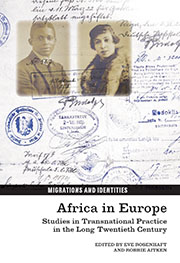Book contents
- Frontmatter
- Contents
- Acknowledgements
- List of Illustrations
- List of Abbreviations
- List of Contributors
- 1 Introduction
- I Enacting Identity: Individuals, Families and Communities
- 2 Prince Dido of Didotown and ‘Human Zoos’ in Wilhelmine Germany: Strategies for Self-Representation under the Othering Gaze
- 3 Schwarze Schmach and métissages contemporains: The Politics and Poetics of Mixed Marriage in a Refugee Family
- 4 ‘Among them Complicit’? Life and Politics in France's Black Communities, 1919–1939
- 5 ‘In this Metropolis of the World We Must Have a Building Worthy of Our Great People’: Race, Empire and Hospitality in Imperial London, 1931–1948
- II Authenticity and Influence: Contexts for Black Cultural Production
- III Post-colonial Belonging
- IV Narratives/Histories
- Bibliography
- Index
4 - ‘Among them Complicit’? Life and Politics in France's Black Communities, 1919–1939
from I - Enacting Identity: Individuals, Families and Communities
- Frontmatter
- Contents
- Acknowledgements
- List of Illustrations
- List of Abbreviations
- List of Contributors
- 1 Introduction
- I Enacting Identity: Individuals, Families and Communities
- 2 Prince Dido of Didotown and ‘Human Zoos’ in Wilhelmine Germany: Strategies for Self-Representation under the Othering Gaze
- 3 Schwarze Schmach and métissages contemporains: The Politics and Poetics of Mixed Marriage in a Refugee Family
- 4 ‘Among them Complicit’? Life and Politics in France's Black Communities, 1919–1939
- 5 ‘In this Metropolis of the World We Must Have a Building Worthy of Our Great People’: Race, Empire and Hospitality in Imperial London, 1931–1948
- II Authenticity and Influence: Contexts for Black Cultural Production
- III Post-colonial Belonging
- IV Narratives/Histories
- Bibliography
- Index
Summary
Migrant Stories
In 1937, the French Guianan Léon-Gontran Damas, an originator of the poetic and political movement of black francophone pride known as negritude, published a volume of poetry titled Pigments He dedicated one poem, ‘Solde’, to a fellow negritude writer, the Martinican Aimé Césaire. The opening stanza reads: ‘I feel ridiculous / in their shoes / in their dinner jacket / in their shirt front / in their detachable collar / in their monocle / in their bowler hat’, and the last stanza concludes: ‘I feel ridiculous / among them complicit / among them pimp / among them cut-throat / my hands horrendously reddened / by the blood of their ci-vi-li-sa-tion.’ The pronouns ‘their’ and ‘them’ refer every time to white Europeans, and to the French in particular. The dedication is fitting since in 1935 Césaire had written an article that referenced the psychological burden of living in France by drawing upon the theme of European clothes. In the first issue of the iconic newspaper L'Etudiant noir, Aimé Césaire published ‘Black Youth and Assimilation’. He wrote: ‘one day, the Nègre grabbed hold of the White [man]'s tie, seized a bowler hat, donned it, and left while laughing …’. Césaire's article used the theme of fashion to advise against assimilation, stating that the black youth wanted to be themselves and resurrect their blackness rather than succumb to European standards. He warned those who accepted assimilation that the colonisers would soon tire of mere copies of white men: ‘assimilation, born of fear and timidity, always ends in scorn and hatred’.
- Type
- Chapter
- Information
- Africa in EuropeStudies in Transnational Practice in the Long Twentieth Century, pp. 55 - 75Publisher: Liverpool University PressPrint publication year: 2013

